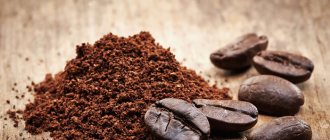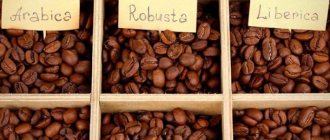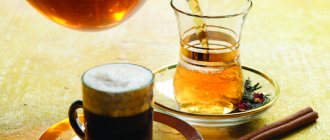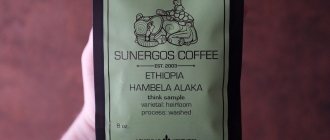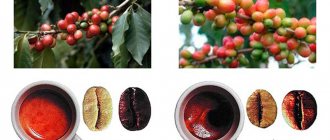Coffee machine type
Popular devices for making coffee are bean, carob and capsule coffee machines. They fully or partially reproduce the brewing and serving cycle of the drink, and are also easy to use:
- Grain - devices that include tanks for grains and water, a coffee grinder, a heating element, a unit for preparing coffee, and tubes for supplying it. To brew delicious espresso, the user just needs to pour the blend into the receiver and press the “Start” button.
- Carob - semi-automatic devices for boiling and brewing drinks. The disadvantages of the machine include manual loading of coffee tablets. To prepare them, use a medium-fine ground mixture and a special metal mold.
- Capsule coffee machines are the quietest coffee machines in the automatic family. The advantages are minimal waste and low energy consumption. To activate the process, just throw the capsule with the extract into the receiver and press the button.
Having decided on the type of coffee machine, the user proceeds to selecting a product. Gourmets recommend paying attention to the quality and composition of the mixture.
An ideal coffee bean must meet the following criteria:
- The gas valve on the body of the package is a filter for removing carbon dioxide, which is released by the grains in the first week after roasting. Without it, the product may suffocate and the packaging may burst.
- Tightness. When exposed to oxygen, coffee loses up to 30% of its essential oils. Torn and crumpled packaging will not be able to preserve the taste and aroma of the product.
- No chips on the surface of the grains, as well as stones and impurities in the blend. When they get into the coffee grinder, they deform/split the millstones and cause breakdowns.
- Dry and ripe grains. Oily and green kernels clog the feed channels and deform the walls of the coffee grinder.
- Pure blend without flavoring additives. Caramelized and flavored grains cause the millstone to flood and lead to equipment failure. To diversify the taste of the drink, it is enough to purchase a coffee machine model with aromatic profiles.
When choosing/preparing ground coffee, baristas are advised to focus on the degree of grinding:
- The optimal fineness for grain and carob machines is medium. A large mixture has a bad effect on the extraction of the drink, while a small mixture quickly clogs the coffee supply path.
- Medium degree of roasting, because... finely ground dark varieties give a very bitter taste, while light varieties give a watery taste.
- For automatic coffee brewing, you can use only natural raw materials. It is strictly prohibited to load soluble powder into devices. It is unsuitable for the formation of coffee tablets and has a high concentration of substances. Connoisseurs of this drink can purchase a coffee machine with a special compartment for freeze-dried powder for 1 cup.
The product for capsule machines is the easiest to choose. In order not to spoil the taste of coffee, you should use capsules of the same brand and blend. This is due to the fact that when brewing, the essential oils of each mixture settle on the tubes of the device. Because of this, when you send a new blend into the system, you may end up with a strange flavor bouquet. However, brands and varieties can be alternated between cleanings.
Treatment
When choosing coffee, some manufacturers indicate on the label the method of processing the raw materials.
There are two main methods:
- dry (natural) method,
- wet (washed) method.
The way coffee is processed - washed or dry - affects its characteristics, because of this, one variety can vary greatly in taste, even if it is grown in the same year and on the same plantation. These are the two most common methods, there are others.
The natural process is the oldest and most common processing method in Brazil and Ethiopia. The birthplace of this method and coffee itself is Africa. In general, this method requires careful attention, since uneven drying can lead to the appearance of a fermented taste and mustiness in the grain.
If you have a choice, it is better to give preference to grains with a dry processing method. But these are nuances. Blended coffee usually uses 3-5 types of beans and such information is not indicated on the packaging.
Mixture composition
The basis of natural coffee is Arabica and Robusta beans. The former give the drink aroma and taste, the latter – strength. Both varieties are presented on store shelves in their pure form, as well as their mixtures. They are used to prepare various types of coffee: ristretto, lungo, latte, cremo and others.
Bean coffee machines can reproduce up to 20 recipes. Most of them are based on 1-2 shots of espresso. Manufacturers produce hoods marked “ESPRESSO” specifically for such devices. They contain 80% Arabica and 20% Robusta. These are quite strong and aromatic mixtures with good extraction potential.
The taste and quality of coffee also depend on the region where it is grown and the quality of roasting. For example, beans from Costa Rica are famous for their rich notes of malt and ripe berries, while South American Robusta has a bright cocoa and cereal flavor.
Fat content of coffee
Dark roast coffee or coffee that has been sitting for a long time can release oil stains on the surface of the bean. This is usually visible at first glance. With medium roasting, coffee oil remains in the body of the bean itself, and with long roasting, oil begins to release to the surface. And these beans, no matter how much you like them or want them, cannot be used in automatic coffee machines. When grinding, coffee beans with an oily coating, just like wet coffee, stick and clog the millstones and they stop grinding. In order to clean the coffee grinder, you will have to disassemble the entire coffee machine. - Do you need it?
Coffee beans with a greasy sheen should not be used, as should wet or flavored coffee.
Roasting degree
To give the beans a fruity sourness, the coffee berries are dried under the sun for a long time. After this, the kernels are peeled and subjected to heat treatment. The degree depends on the roasting temperature:
- Light roast. This category includes 2 degrees: Scandinavian (2000C) and American (2200C). The first is the lightest, suitable for brewing in a cup, the second is for making espresso. American roasting imparts a sweet, herbal flavor to the beans and sounds great in dessert drinks.
- Medium “Vienna” (2350C) is the best option for beginner coffee lovers. It has a balanced taste.
- Dark: “French” (2400C), “Italian” (2450C), “Spanish” (2500C) – bitter blends with notes of caramel. The darker the roast level, the brighter the dessert sounds and the less herbaceous it is. Dark blends 2400 and 2450 reveal the maximum bouquet with coarse grinding and acquire a burnt taste with medium and fine grinding. In this regard, baristas do not recommend using them for coffee machines.
The quality of roasting affects criteria such as the astringency and richness of the coffee.
Secrets of grinding coffee.
If the instructions indicate the use of predominantly grain coffee, then it is better to refrain from experimenting with ground coffee, since in this case an unpleasant sediment will be found at the bottom of the cup of the finished drink. However, the negative qualities of ground coffee do not end there. The second disadvantage is the rapid loss of taste. Experienced baristas recommend grinding coffee right before brewing. This allows you to preserve quality, deep taste, and aroma.
If you follow the rule of preparation (grinding) immediately before preparing the drink, you can note that the process is especially noisy, since coffee beans have a fairly dense structure.
It is important to note the fact that coffee grinders with steel blades, due to their high strength, create much more noise compared to ceramic knives. Therefore, when choosing a place, it is important to consider that the sound of grinding grains can bring negative sensations to others.
Three most important characteristics that affect the taste of coffee.
1. Grinding
Remember: the finer the beans are ground, the more flavor is revealed. Coffee brewed from fine grinding has a more pronounced bitterness, richness, and persistent foam.
2. Roasting
There are three main types of roasting:
– Light
The roasting temperature is 220 degrees. Thanks to strict adherence to technology, this type of roasting helps to reveal all flavor facets, preserve the characteristic sourness, and emphasize sweet notes.
– Average
With this type of roasting, the temperature is 230 degrees. This type of roasting gives a stronger taste than the previous one, which is why it is the most common.
– Dark
The temperature of such roasting ranges from 240 to 250 degrees. At the same time, the sourness disappears, and notes of caramel appear in the taste. Usually this coffee is more “sticky”, enveloping
There is a simple rule: the stronger the roast, the coarser the grind. This rule allows you to achieve a balance of taste without making the coffee overly bitter or sour.
Amount of finished drink
The smaller the volume of the drink, the more concentrated the taste, although there is less caffeine-containing component. The more water, the less intense the coffee, but the more caffeine.
The strength is also influenced by the amount of beans ground to prepare a serving of coffee, rather than water. The more beans, the stronger the coffee.
Roasting and packaging dates
Conscientious manufacturers indicate on the packaging of the product the date of its sorting and the time of frying. The amount of essential oils in the product depends on these terms:
- 2-3 weeks after roasting is the ideal period for beans. They released carbon dioxide, but retained essential oils and beneficial compounds.
- 30 days – fresh coffee with good extraction potential.
- 60 days – good grains, having lost about 3% of taste and aroma.
- 4-5 months - mixtures that are recommended to be consumed within 1-2 weeks after the packaging is depressurized.
Blends prepared more than six months ago lose 30% of essential oils and have no taste.
When choosing a roasting date, factors such as bean consumption are taken into account. Fresh mixtures retain their taste from 15 to 20 days after unpacking, old ones - about a week. With low coffee consumption, such raw materials can erode and lose their taste.
Some gourmets prefer to make their own blends. In this case, it is necessary to check the roasting dates of the mono-blends. It is not recommended to mix grains of different ages, as they have different concentrations of volatile compounds. A fresh variety will “clog” the notes of the old one, and the final bouquet will become uncertain.
You should also take care of storage containers. To reduce contact with air, the grains are poured into sealed containers. These can be tin, ceramic or glass jars with a lid, or ZIP bags. Some manufacturers produce mixtures with a special lock. It helps retain up to 15% of the taste and extend shelf life.
Ground and capsule coffee are made from coffee beans of various roasts. Finished products are packaged in sealed disposable containers with a date stamp. In this case, the processing time of the raw materials remains unknown, and the user can only rely on the shelf life. In vacuum packaging, the powder lasts from 1 to 3 years, when opened – up to 3 months.
Freshness
The main misconception is that coffee can be stored for a long time, almost forever. This is a big mistake and, one might say, a key one! Coffee can perhaps be compared to chocolate candies in paper candy wrappers, which after production will be delicious for three months, and if after purchase they sit for 6 months, a year or even two, then there is great doubt whether you will offer them to your children and whether you will eat them yourself. Yes, it is possible that sweets, just like coffee, will remain safe for health, but there is no doubt that they will no longer be as fresh. The thing is that when coffee is roasted, the fermentation process starts, chemical processes begin in which coffee gradually changes and loses its taste and aroma over time. Large manufacturers pump nitrogen into the packaging, which slows down the oxidation process and preserves the coffee, but in our opinion this does not save for long. The manufacturer often writes that the shelf life is 1 or 2 years. But no matter how wonderful and elite the coffee is, after 6 months, and even more so a year or two after roasting, it most likely will not be unsuitable for preparation, but in our opinion this is just like making coffee from sawdust and fir cones.
When buying coffee, the first thing you need to look at is the production date! Secondly, the variety or mixture is important. For example: if you compare an elite type of coffee that has been lying in warehouses and store shelves for more than 6 months and a freshly roasted one that is only a couple of weeks old, then the first one, at best, will taste like a not-so-best instant coffee, but you will definitely enjoy freshly roasted coffee!
The question arises: why is this so? In reality, coffee is a berry, a carefully grown, processed agricultural product. So the fresher the better.
Now we know how to choose coffee from hundreds of offers! We buy beans that have the roasting date clearly printed on them. A manufacturer that can't tell us this information probably just doesn't want to.
After opening the package of coffee, it should be used within a week, or two at most. During this period, the coffee will be as aromatic and tasty as possible. To prevent it from running out of steam, carefully close the bag using clamps or other means, the main thing is to reduce the contact of the grains with air.
Coffee can be used for up to 4 weeks after opening the package, but after 14 days the quality and intensity of the aroma will begin to fade.



